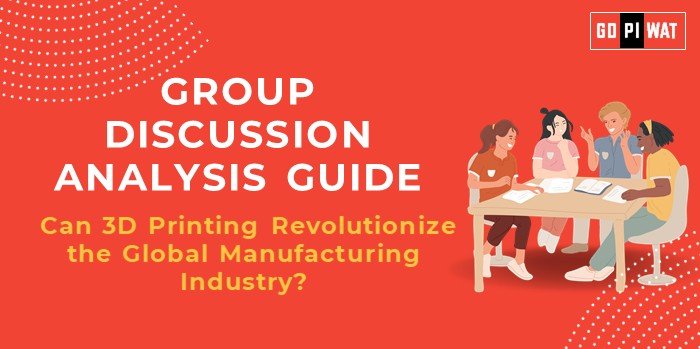📋 Group Discussion (GD) Analysis Guide
🏭 Can 3D Printing Revolutionize the Global Manufacturing Industry?
🌐 Introduction
3D printing, or additive manufacturing, is a transformative technology enabling material deposition layer by layer to create complex objects. From customization to sustainability, it offers exciting possibilities that challenge traditional manufacturing paradigms. With accelerating adoption across industries, its role in shaping the global manufacturing landscape is increasingly significant.
📊 Quick Facts & Key Statistics
- Market Value: The global 3D printing market is projected to surpass $32 billion by 2023, growing at a CAGR of over 25% from 2017 to 2023.
- Adoption Rate: In 2015, 3D printer shipments in the U.S. increased by nearly 20% compared to 2014, highlighting rising adoption.
- Waste Reduction: For certain metal parts, 3D printing reduces material costs by up to 90%, minimizing waste.
- Energy Savings: The technology enables energy savings of up to 50% in the production of specific components, contributing to sustainable manufacturing.
👥 Stakeholders and Their Roles
- Governments: Support research, innovation, and regulatory frameworks.
- Corporations: Integrate 3D printing into production for customization and efficiency.
- Startups: Explore innovative applications in healthcare, automotive, and aerospace.
- Educational Institutions: Advance R&D in materials and scalable processes.
- Consumers: Drive demand for personalized, eco-friendly products.
🏆 Achievements and Challenges
- Achievements:
- Innovation in Prototyping: Enables rapid prototyping across industries, reducing time-to-market.
- Material Efficiency: Significant reduction in waste, especially in high-value materials like metals.
- Sustainability: Energy-efficient production processes contribute to reduced carbon footprints.
- Challenges:
- High Initial Costs: Equipment and material expenses remain a barrier for smaller companies.
- Material Constraints: Limited options for complex applications in large-scale production.
- Regulatory Hurdles: Lack of consistent global standards impacts product quality and safety.
📝 Effective Discussion Approaches
- Opening Approaches:
- Start with a Statistic: “The 3D printing market is projected to grow at a CAGR of over 25%, reaching $32 billion by 2023, highlighting its transformative potential.”
- Pose a Question: “Can 3D printing overcome cost and scalability issues to revolutionize global manufacturing?”
- Counter-Argument Handling:
- “While initial costs are high, advancements in material technology and economies of scale are reducing barriers to entry.”
🔧 Strategic Analysis of Strengths & Weaknesses
- Strengths: Customization, waste reduction, localized production.
- Weaknesses: High costs, material limitations.
- Opportunities: Industry 4.0 integration, emerging markets.
- Threats: Technological bottlenecks, intellectual property issues.
🗣️ Structured Arguments for Discussion
- Supporting Stance: “3D printing minimizes waste, saves energy, and supports rapid prototyping, fostering innovation across industries.”
- Opposing Stance: “High costs, material limitations, and regulatory hurdles challenge its widespread adoption in global manufacturing.”
- Balanced Perspective: “While 3D printing holds revolutionary potential, addressing its economic and technological barriers is essential for mainstream integration.”
🎓 Connecting with B-School Applications
- Real-World Applications: Explore 3D printing’s role in reducing supply chain inefficiencies or achieving sustainability goals.
- Sample Interview Questions:
- “What industries can benefit most from the adoption of 3D printing?”
- “How does 3D printing contribute to sustainable manufacturing practices?”
- Insights for Students:
- Focus on 3D printing in projects related to sustainability or supply chain optimization.
- Analyze its potential for cost reduction in case competitions.


